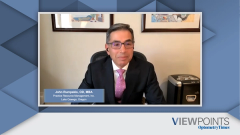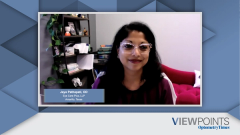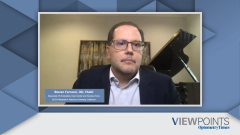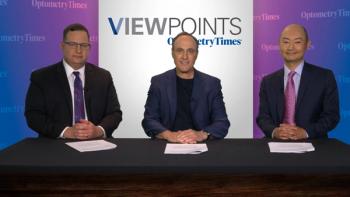
Routine Follow-Up Care to Monitor for AMD
Current practices monitoring patients with age-related macular degeneration and insight on how to help reduce out-of-pocket costs for patients during routine follow-ups.
Episodes in this series

John Rumpakis, OD, MBA: In the typical clinical setting without remote monitoring, how often are you seeing a patient who may be predisposed or have a genetic predisposition if you’re doing genetic testing? For those individuals showing signs, symptoms, and things like that, how often are you seeing them in the office?
Steven Ferrucci, OD, FAAO: It depends on their level of macular degeneration. I take 2 things into account. I consider their level of macular degeneration by looking at their macula and grading, perhaps not quite as scientifically, what came out of the AREDS study. I use that as a background to qualify the level of macular degeneration—mild, intermediate, or advanced—and then base my follow-up on that. On top of that, I’ll use other risk factors—patient history, family history, or other things—to determine when I want to see that patient again. In short, depending on the patient’s level of macular degeneration and other risk factors, it can be as soon as every 3 months or perhaps as much as once every 12 months, depending on their level of maculopathy.
Steven Ferrucci, OD, FAAO: Jaya, how about for you? Is it about the same?
Jaya Pathapati, OD: It’s pretty much the same. Lifestyle—there are patients who are more worried. They’ve seen their parents go blind and so forth, and they want to be monitored more closely. As soon as there’s a lifestyle index that shows that they’re at a higher risk or have a family history, I start the discussion. This is something we need to be monitoring, especially after age 50. If they are smokers, then we always start the discussion of quitting smoking and talking to their primary care to get help. The discussion is starting way before, and I might be seeing them once a year. But if they look like they have some changes, or something is starting with drusen, I will see them sooner—6 months, 3 months. But we start planning on their lifestyle way before we start seeing any maculopathy.
John Rumpakis, OD, MBA: I’m going to introduce another topic as a segue, but we’ll talk about some of the coding and billing aspects later. When monitoring a chronic disease, we also must worry about insurance benefits and those types of things and how insurance carriers are starting to dictate the frequency of different procedures that we can do. Maybe an OCT [optical coherence tomography] 2 times a year, or intertwined or alternating with a visual field as part of their clinical protocols. Steve is in a VA [Veterans Affairs Medical Center] setting, so you don’t have to worry about that as much. You can pretty much practice at will if you wish. Jaya, do you find that that impacts you in your private practice?
Jaya Pathapati, OD: Yes, quite a bit, and I also like to talk to the patients about it. We want to minimize their out-of-pocket expense because a lot of people can’t afford to keep coming every 3 months. I talk to them. A lot of patients come vision insurance, which of course they want to use. We’ll say, “Let’s go ahead and use your vision insurance, but because of your risk factors and what I’m seeing, I’m going to have you come back in for your medical testing.” Then we’ll have a game plan for the year. I’m going to go ahead and get a fundus photo. The fundus photo—once I see some drusen—is vital to show the patients what they’re seeing.
If I show them an OCT, they say, “It’s like an MRI. I’m not really understanding.” But visually seeing that fundus photo in front of them, we can say this is what’s causing that damage for your vision down the road, and this is what we need to prevent. I’ll show them a picture of a fundus photo that’s advanced AMD [age-related macular degeneration] so they can see the difference. And I say, “This is where you need to be.” That sets their mind: “This is a normal, healthy eye, and this is where I do not want to go.”
From there, we plan: “We’re going to come back in, and going to take an MRI of your macula, going underneath so we can further assess. That gives them the idea that the next time they come in, they’re going to be doing this. There are some patients for whom the vision is affected. We have the privilege of having ERG [electroretinography] and VEP [vision-evoked potential] testing, so we can run those if there’s a patient I need them for. But I’m going back and looking saying, “How many times can I do this? How can I adjust the coding to minimize that out-of-pocket expense for the patient?”
Transcript edited for clarity.
Newsletter
Want more insights like this? Subscribe to Optometry Times and get clinical pearls and practice tips delivered straight to your inbox.













































